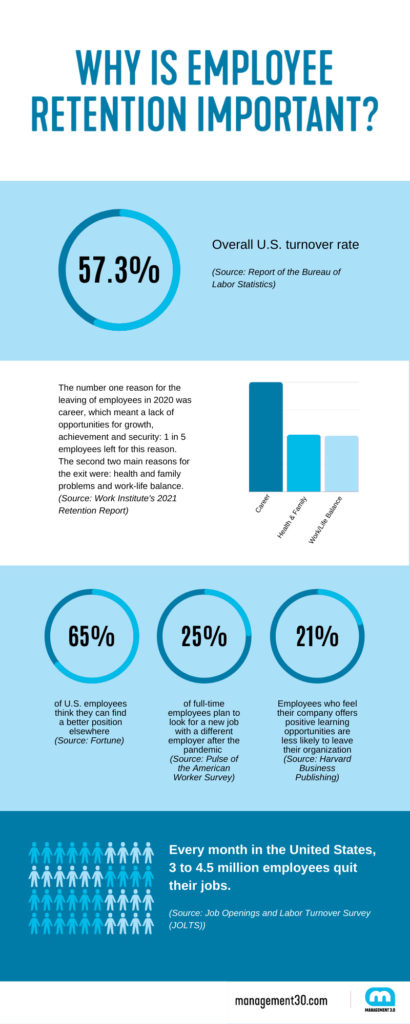Employee retention in times of the pandemic is occupying one of the essential areas for organizations. Management 3.0 Facilitator Erick Masgo Dávila, advanced in Agile HR and also facilitating Agility in HR workshops, took a closer look into the topic and numbers.
- What does employee retention mean?
- Why is employee retention important?
- Causes of high employee turnover
- The Cost of Employee Turnover
- Effective Employee Retention Strategies
Before we dive in, let’s gain some clarification first: Employee retention, what is it about?
What does employee retention mean?
Employee retention is the ability to hire and keep employees for a long period, avoiding rapid employee turnover. This means that companies have to create a welcoming environment for their staff and make it worthwhile for people to stick around, rather than move onto something else. Companies have to balance giving people autonomy with enough direction, while giving people the opportunity to grow and most importantly making people feel like they’re valued and that their work is contributing to something greater than themselves.
The term “retention” can lend itself to misinterpretations in the implementation of this strategy. Here are some examples of unfair practices:
- Increase the salary of all employees without making any distinction of performance or commitment to the company.
- Prevent employees from resigning due to a bad work environment, organizational disorder, lack of leadership, or mistreatment.
- Retain employees only to avoid high costs of compensation or training and training of new staff.
- Redistribution of work and automatic promotions without a development plan.
- Transfer of employees to another office or branch in an improvised manner.
Why is employee retention important?
Did you know?
- The overall U.S. turnover rate is 57.3% (Source: Report of the Bureau of Labor Statistics)
- 65% of U.S. employees think they can find a better position elsewhere (Source: Fortune)
- Every month in the United States, 3 to 4.5 million employees quit their jobs (Source: Job Openings and Labor Turnover Survey (JOLTS))
- 25% of full-time employees plan to look for a new job with a different employer after the pandemic (Source: Pulse of the American Worker Survey)
- Employees who feel their company offers positive learning opportunities are 21% less likely to leave their organization (Source: Harvard Business Publishing)
- The number one reason for the leaving of employees in 2020 was career, which meant a lack of opportunities for growth, achievement and security: 1 in 5 employees left for this reason. The second two main reasons for the exit were: health and family problems and work-life balance. (Source: Work Institute’s 2021 Retention Report)
All these indicators allow us to understand the importance that organizations have to give to employee retention.
Today, having excellent human talent is not an easy task. Many companies have to dedicate a lot of time and resources to build a valuable workforce.
Having valuable workers in a company, who give extra value, an advantage over the competition, and who want to stay in the organization generates numerous benefits such as:
- Increased efficiency at work due to the greater ability to detect weaknesses and strengths and implement continuous work performance improvement.
- Improved performance by a greater motivation to achieve objectives.
- Increased employee satisfaction by seeing their effort, their work, and their talent rewarded.
- Increase in customer satisfaction, which implies loyalty that is linked to the results of the company.
- Strengthening of the organizational culture.
All this impacts a lower percentage of staff turnover since you will have talented, satisfied employees who want to stay in the company longer.
100% staff retention will never be achieved by a company. And you shouldn’t expect to do so as a certain percentage of turnover can be favorable. However, excessive turnover would create a problem for any business that can bring short- and long-term consequences for the company. For this reason, companies are interested in keeping talented employees on board since the consequences of not doing so are mainly the high costs of hiring and training, the lack of qualified personnel, and the decrease in morale in the workplace.
Causes of high employee turnover
The most common causes of high staff turnover are:
1. Employee and company do not match causing high employee turnover
Selecting a good candidate for a job goes beyond choosing the person who has a brilliant resume. A good candidate will have the optimal skills and capabilities to develop their position and have to fit with the company’s culture to which they are applying. The brightest professional will be useless if he does not match the organization’s values.
2. Cause of high employee turnover: The work did not turn out as expected
Many leave because the work didn’t turn out to be what they initially thought. This is because in some opportunities, there is no good communication strategy within the human resources department, and this makes it difficult to understand the job roles clearly. It may also be that the hiring managers have concealed information about the roles and responsibilities of the position or the true purpose of the job.
3. Missing opportunities for professional growth within the company
Nobody likes to feel stagnant at work, everyone wants growth, and if the organization does not offer them opportunities internally, they will end up resigning. The more professionals organizations have, the greater their aspirations, and they will look for challenges that allow them to grow professionally.
4. Missing continuous feedback causing high employee turnover
43% of employees who have a solid commitment to their organization receive feedback once a week.
Employees want to know if what they are doing is going well and if there are aspects that can be improved, and they want this constantly. Giving a review every six months or every year is not enough, it generates demotivation and stagnation in the performance of employees, and a great opportunity for professional growth and continuous improvement is lost.
Read on to learn about how to create a healthy feedback culture

5. No good relationship with the boss causing high employee turnover
The relationship between the employee and the boss is fundamental. Therefore, one of the common reasons for employee turnover is that they want to get away from their bosses. One of the most frequent reasons they resign is due to a lack of trust in the boss, not because of a personal quarrel. There is a direct relationship between the level of comfort employees feel with their boss and how much they are committed to their work.
6. Missing work-life-balance as a reason for high employee turnover
Employees are happiest when they have flexible work schedules and enough time to deal with personal matters beyond work.
The benefits of flexibility give employees freedom and responsibility. It also creates a healthy environment for them to work, makes them feel more comfortable, and motivates them to stay on a voluntary basis.
If employees are not satisfied with the balance they get from their life and work, they will be affected in their motivation, productivity and this will make them explore new job opportunities.
7. Cause of high employee turnover: Missing appreciation
According to ProofHub, 50% of employees believe that their manager’s appreciation helps them create engagement. And 69% think they would try even harder if they received recognition.
Not being recognized when a good job was done, being treated without respect, being asked to work in precarious conditions, and not receiving the necessary resources to work are examples of things that make an employee not feel valued.
Good managers devote efforts to getting to know their employees by giving them confidence to feel comfortable talking about any topic, this or not related to work, which will allow employees to feel safe enough to experiment, challenge, share information, and support each other.
8. Unfair salary causing high employee turnover
Receiving less financial compensation than employees consider appropriate based on their duties, training, knowledge, and experiences can also cause many rotations.
Employees need to know that the work they do is being rewarded through recognition and a salary quota according to their responsibilities, experience, and knowledge, and that is fair.
The Cost of Employee Turnover
Employee turnover is expensive. Losing great employees and then having to replace them, sometimes over and over again, is costly. According to an economic press release from the U.S. Bureau of Labor Statistics, the average number of years employees have worked for their employer is currently 4.1 years. However, this may vary according to age and occupation:
- The average tenure of employees from 25 to 34 years is 2.8 years.
- The average tenure of employees from 55 to 64 years is nine years.
- Employees in managerial, professional, and related occupations had the highest average seniority (4.9 years).
- Employees in service occupations had the lowest average seniority (1.9 years).
An Employee Benefit News study indicates that employers spend an average of 33% of a worker’s annual salary replacing a single employee.
For example:
- It will cost $12,000 to replace a junior employee who earns $36,000 a year.
- It will cost $20,000 to replace a manager who makes $60,000 a year.
- It will cost $50,000 to replace an executive who earns $150,000 a year.
One of the most complicated issues to quantify for the areas of Human Resources in companies is the cost of replacing an employee who has been disassociated or who voluntarily resigned.
To quantify it, the first thing that must be identified are the types of costs involved in the rotation of personnel and among which we have: direct cost of recruitment, expenses due to falling in productivity, and temporary reduction of the cost of labor
The direct cost of recruitment
Two factors directly impact the direct costs when replacing an employee: selection and training.
For example, we have to replace an executive whose salary is $5,000 per month. If the search is to be carried out externally, the cost would be $10,000, taking into account that the traditional values of the market if a selection is made at the managerial level with a headhunter is approximately twice the salary of the executive. If the choice is made internally, it would be necessary to establish a calculation that considers the team’s salary dedicated to the recruitment, the hours allocated to the search, investment in ads on social networks, or any other way. On the other hand, the cost invested in their training should be fixed proportionally to the person’s salary to be hired. In summary, the calculation would be as follows:
- Selection Cost: $10,000
- Training Cost (Induction and Training): $5,000
- Total Direct Cost: $15,000
Temporary reduction in labor cost
The leave of an employee brings a decrease in the labor cost, considering the income that the person perceived in the company and the number of days that the position will be vacant. Continuing with the previous example, someone in an executive role who earns $ 5,000 monthly has an approximate annual cost of $ 80,000 for the company and assuming that the average time to replace this person is approximately 45 days (represents 12.3% of the year). The result would give us a temporary reduction of the cost of $ 9,840. In summary, the calculation would be as follows:
- Annual Cost (including benefits): $80,000
- Average time to select: 45 days (represents 12.3% of the year)
- Temporary reduction in labor cost: $9,840 ($80,000*12.3%)

Cost per drop in productivity
This is one of the concepts that are usually omitted and can be very representative. It is expected that if an employee with a certain level of experience and knowledge has been disengaged, whoever replaces him will not be able from the first day to reach the same level of productivity as his predecessor. Learning curves can be different depending on the profile of the person and their professional maturity.
Continuing with the previous example, we will consider the following variables: Average replacement time of the executive position equal to 45 days and estimated time to reach a good level of productivity comparable to 60 days. This would not give a total of 105 days of non-productive days (representing 28.7% of the year).
Best practices indicate that the income that an employee generates for the company should be around three times their annual compensation, which in the example would give us an average yearly income per employee of $240,000 (considering an annual cost of $ 80,000). This would provide us with as a final result the value of $68,880 per drop in productivity. In summary, the calculation would be as follows:
- Average time to select: 45 days
- Average time to the productivity level: 60 days
- Total non-productive days: 105 days (represents 28.7% of the year)
- Average annual income per employee: $240,000
- Cost per drop in productivity: $68,880 (240,000*28.7%)
Performing then the final calculation, adding the direct costs and falling productivity, and then subtracting the temporary reduction of the labor cost, the result is as shown below:
- The direct cost of recruitment: $15,000
- Cost per drop in productivity: $68,880
- Temporary reduction in labor cost: $9,840
- Total Cost of Rotation for Loss of an employee: $74,040
This same analysis should be carried out throughout the organization at its different hierarchical levels to determine what is the turnover of personnel that is taking place and the economic impact it represents for the company.
Tip: To do your own calculation you can also use tools such as sparkbay, which has created an online calculator to determine the cost of employee retention.

Effective Employee Retention Strategies
Now more than ever keeping good workers is essential. A valuable employee can make a difference at such a time; but, if you as an employee are not happy, you will try to find something better or that fits your current circumstances. The easiest method for many to retain talent in the company is to pay more. However, many companies can’t afford that option right now, which is still recovering. In addition, the coronavirus crisis has changed the way of working and the priorities of many workers.
Loyalty to employees does not mean paying them more but offering them something they need and value.
In that sense, organizations must work on effective employee retention strategies such as the following:
1. Provide opportunities for growth and development to retain employees
Investing in employee development is critical to an organization’s success. But it is even more important to prepare employees to develop their work better and become better professionals.
When an organization creates professional development opportunities and invests in training, mentoring, and coaching to improve its internal processes, it relies on its employees to grow, no matter the risk of losing them. In this bet also comes the responsibility of providing them with opportunities to develop even more, with challenges that allow them to put into practice what they have learned and at the same time give them the freedom to contribute to the organization at a level they would never have imagined.
2. Effective Employee Retention Strategies: Foster a culture of feedback and recognition
Feedback on employees’ work is vital since the trust of these can be made or broken by not providing appropriate feedback. An excellent quote from Therese Huston, author of the book The Simple Way to Make Giving Feedback Easier, is: “If you want people to be receptive to constructive feedback, start by saying your good intentions out loud.”
But even more critical than providing effective feedback is recognizing employee successes. Recognition of good work is a motivator that creates organizational cultures where everyone feels motivated and appreciated.
If the organization recognizes and provides well-intentioned feedback, employees will feel in a place where they are appreciated and where they can learn to grow.
3. Develop Agile Leadership as part of your employee retention program
A company with leaders, rather than bosses, will be more likely to have more engaged employees. Having good leadership is considered a crucial factor for talent retention. It is a reality that not all people are born leaders. But it is a possibility to develop and cultivate this skill.
Organizations must develop leaders with an Agile Leadership style, which is proposed by Management 3.0. These leaders communicate well, lead by example on a day-to-day basis, take responsibility, and inspire staff to reach their full professional potential.




